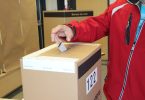
To better understand the health of lobsters through « blood tests »
Merinov is optimizing two types of biotests to help industry manage their lobster stocks.
In collaboration with the Université du Québec à Rimouski and Fruits de mer Madeleine, the team is using hemolymph punctures, i.e., « blood tests » on shellfish once they are returned to the factory.
« The tests aim to determine lactate and histamine levels, » says Merinov research professional Noémie Pelletier.
She explains that these two molecules serve as indicators of the state of health of lobsters with respect to environmental factors, an answer that is completed by research assistant and doctoral candidate at UQAR, Camille Berthod.
Pelletier says that eventually, the team will establish lactate and histamine thresholds that industry can use to quantify the quality of shellfish and then decide what to do with them.
For his part, Camille Berthod mentions that hemolymph samples are already used in the field and that the method has many advantages.
The biotests are currently being tested this summer at Fruits de mer Madeleine and could be implemented on a larger scale next fishing season if the approach is successful, adds Noémie Pelletier.
At a cost of $100,000, the project named « Homadiag » is financed by the Fonds de recherche du Québec-Nature et technologie.





